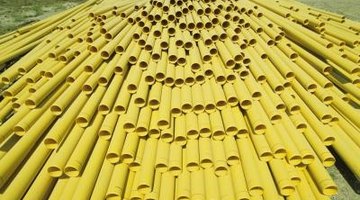Types of Pipe Used in Sewer & Leach Fields
Leach and sewer fields use pipes buried in sandy or gravel soils to disperse the sludge and wastewater that builds up within a septic tank system. Residential and commercial buildings both use septic systems in areas where it is difficult to link a sewer system to a municipal sewer line, the Plastics Pipe Institute reports.
Septic Systems

The common composition of a septic system includes a sewer drain, septic tank, distribution box and leach field, according to the New York State Department of Health. The purpose of piping leading to and used in leach fields is to transport contaminated wastewater into a leach field where it is absorbed into the soil and other materials in the area to decompose. Sandy and gravel soils are commonly used to allow the movement of wastewater through the ground; septic tanks are positioned carefully to avoid contamination of groundwater supplies and areas such as swimming pools.
Smooth-Walled Pipes
The traditional method creating a leach or sewer field for removing effluent water from septic systems is to create a gravel environment into which pipes are inserted. In these systems, high-density polyethylene pipes are used to transport effluent liquids through the field. These pipes are usually smooth-walled on both the interior and exterior; these smooth-walled pipes are perforated to allow wastewater to pass or leach into the gravel through which the wastewater is filtered before it enters the environment.
Corrugated Pipes
Other options have been created to smooth-walled pipe systems; these include corrugated pipes capable of being curved to fit into the available property surrounding a building. Corrugated pipes can be lined with a form of geotextile instead of the traditional gravel used to filter wastewater, the Plastics Pipe Institute reports. In most corrugated HDPE piping systems the soil that naturally makes up the leach field surrounding the pipes is used to cover the piping.
Size
Corrugated HDPE leach field pipes are generally smaller in size than smooth-walled piping systems, according to the Plastics Pipe Institute. The size of the leach field and choice of pipe should be assessed by a qualified engineer. Both smooth-walled and corrugated piping can be used in traditional gravel sewer fields; these are buried in gravel-filled trenches of between 2 and 3 feet depending on the amount of waste deposited in the septic system. Smooth-walled systems are issued in measurements of 4 to 6 inches for residential septic systems, while corrugated piping is available in sizes from 3 inches and up. In systems without gravel, corrugated pipes are required to at least 8 inches in size.
References
Writer Bio
Paul Cartmell began his career as a writer for documentaries and fictional films in the United Kingdom in the mid-1990s. Working in documentary journalism, Cartmell wrote about a wide variety of subjects including racism in professional sports. Cartmell attended the University of Lincoln and London Metropolitan University, gaining degrees in journalism and film studies.
Photo Credits
- Andy Sotiriou/Photodisc/Getty Images
More Articles



